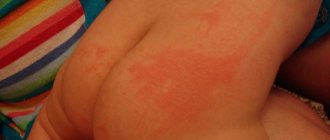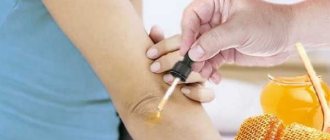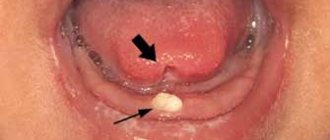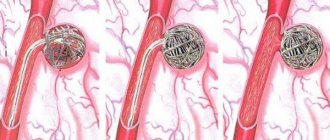The transition from intrauterine development to life in the outside world is associated with major changes in almost all organs and systems of the newborn’s body. And although these changes are inherent in nature, a certain time must pass for the baby to adapt to them - this is called transient states. There are several of them, and they develop individually in each baby. Many of these conditions have no clinical manifestations and do not cause obvious inconvenience to either the baby or his mother. But there are those that are noticeable to parents and often cause them concern. They will be discussed in this article.
Physiological weight loss
In the first few days of its life, every baby loses weight. This is a natural process that occurs because a lot of water comes out of the newborn’s body, and he has to use the reserves of nutrients received in utero. There is also relative starvation, which is associated with a deficiency of milk in the mother in the first days after childbirth. The norm is weight loss not exceeding 6-10% of the baby’s initial body weight. As a rule, by 8-10 days full-term babies and by 14 days premature babies gain the weight they had at birth.
After this, the child’s weight regularly increases. Pediatricians and parents closely monitor this indicator, as it indicates proper development.
Rapid restoration of a child's weight is facilitated by:
- early breastfeeding,
- free feeding mode,
- compliance with thermal conditions,
- prevention of hypogalactia in mother,
- rational baby care.
Who is at risk?
The child is sleeping
In addition to babies, whose bodies are affected by the factors listed above, newborns who receive their mother’s breast milk are most often susceptible to the development of toxic erythema, oddly enough. This is due to the fact that a woman can eat prohibited foods, eat a lot of sugar, drink coffee, smoke, and drink alcohol.
All toxic substances and potential allergens enter the baby's body through breast milk, increasing the risk of developing toxic erythema and other pathological skin conditions. In babies who are bottle-fed and receive formula, erythema occurs much less frequently.
Heat imbalance
Borderline conditions in newborns also include a transient disturbance of heat balance or metabolism. The baby's body temperature may fluctuate - increase or decrease, usually slightly. This is easy to explain. Thermoregulation processes are still immature and imperfect, very sensitive to environmental changes. A child's heat balance depends on any fluctuations in indoor or outdoor temperature.
Therefore, it is extremely important to ensure a suitable temperature in the room (20-220C for full-term babies, 23-240C for premature babies), protect them from overheating and drafts, and dress according to the weather.
Types of toxicodermy
Toxidermia is classified according to the type of course:
- Erythroderma is an inflammation of the skin, accompanied by redness, swelling, rash of papules and pustules, their erosion, formation of crusts, peeling, a tendency to coalescence and peripheral growth.
- Exudative erythema multiforme – characteristic red spots and blisters on the limbs, body, and mucous membranes. Sometimes accompanied by itching.
- Erythema nodosum is a painful, palpable subcutaneous nodule of red or purple color, often in the lower leg area.
- Lichen planus - itchy small purple papules that can coalesce into scaly plaques and can affect the mucous membranes of the mouth and genitals.
- Allergic vasculitis - subcutaneous capillary hemorrhages.
- Keratoderma is excessive keratinization mainly in the area of the palms and soles.
- Stomatitis is inflammation of the oral mucosa.
- Toxic epidermal necrolysis - intoxication, elevated temperature, formation of extensive weeping blisters with serous-hemorrhagic contents. Accompanied by secondary lesions of internal organs. Life-threatening condition. Source: I.Yu. Melnikova, V.M. Shaytor Toxic-allergic dermatitis in children // Issues of modern pediatrics, 2008, vol. 7, no. 4, pp. 68-74
Sexual crisis
This condition is observed in 2/3 of babies. Most often girls experience this. Rarely – premature babies. This phenomenon is associated with the reaction of the newborn’s body to release from maternal estrogens.
Often in the first week of life in girls, and sometimes in boys, the mammary glands slightly enlarge, but no inflammatory changes are observed on the skin. As a rule, engorgement increases by the 8-10th day of life, and by the end of the first month it subsides. Sometimes a fluid resembling colostrum is released from the baby's mammary glands. This phenomenon is normal! Parents should not be afraid.
In most cases, all of the above treatment does not require. BUT! If the engorgement of the mammary glands becomes significant, and the skin over them is red and hot to the touch, the body temperature rises and the child behaves restlessly, then a consultation with a pediatrician is necessary.
Do not squeeze liquid from your baby's nipples! This can cause pain to your baby and lead to infection.
In the first days of life, girls often experience grayish-white mucous discharge (possibly mixed with blood) from the external genitalia. These are manifestations of transient vulvovaginitis. After a few days, the discharge disappears. All this is also a normal reaction and does not require treatment. Hygienic care and regular washing are required.
Erythema toxicum: what is it?
Panic aside. Erythema toxicum is not at all toxic, although the name suggests that it is something dangerous and extremely contagious. Rashes on the body of a newborn are not caused by infections, pathogenic bacteria, or viruses.
As doctors say, this is a kind of physiological reaction of the baby’s body to changes in environmental conditions. This is how the child’s skin “adapts” to a completely new external world, which is still hostile.
Erythema toxicum is a reddish rash that usually appears 48-72 hours after the baby is born. Cases have been identified where small pimples on the skin appeared much later - after 10-20 days. Redness first affects the baby's face and torso, and then moves to the child's arms and legs. The mucous membranes, palms and soles remain clean.
Skin changes
In the first week of life, transient changes in the skin occur in the vast majority of newborns. The most common ones are:
- Simple erythema or physiological catarrh
is reactive redness of the skin after removal of vernix and the first bath. The erythema intensifies on the second day and disappears by the end of the first week of life (in premature babies - after 2-3 weeks). - Physiological peeling of the skin
. It can be large-plate, small or pityriasis. As a rule, it occurs on days 3-5 of life. In post-term babies, very profuse peeling is observed. No treatment is required; skin peeling goes away on its own. - Birth tumor
. This is swelling of the presenting part of the body due to venous hyperemia, which disappears on its own within 1-2 days. Sometimes small pinpoint hemorrhages (petechiae) remain at the site of the birth tumor, which disappear on their own over time. - Erythema toxicum
. Occurs in many newborns on days 1-3 of life. On the skin - face, trunk and limbs - erythematous spots or papules appear against the background of erythema. Such rashes disappear within a week, but can sometimes persist during the first month of life. The condition of the children is not impaired and no treatment is required. - Milia
. These are white-yellow nodules up to 2 mm in size. Located on the face: wings of the nose, bridge of the nose, chin area, forehead. The formations are accumulations of sebum that have not reached the surface of the epidermis. No special treatment is required. If there are signs of inflammation around the nodules, we recommend treating the skin with an antiseptic solution.
Treatment, prevention
Toxic erythema has a benign course and does not require treatment: after some time, all its manifestations disappear without a trace. However, to avoid complications such as infection, it is necessary to pay special attention to skin hygiene:
- Give your baby air baths more often;
- change contaminated clothing promptly;
- do not allow the baby to overheat or hypothermia;
- do not rub your baby’s delicate skin with a towel after bathing;
- use special bathing products no more than 1-2 times a week;
- Avoid applying baby cosmetics (cream, milk, lotion, oil) to the area of the rash.
It is important to remember that erythema toxicum is not dangerous for the child and there is no reason to panic. It is not inherited and cannot be infected. However, consultation with a doctor if any rash appears, including those that completely coincide with the manifestations described above, is still necessary: only a neonatologist can clearly distinguish harmless toxic erythema from a dangerous infectious disease accompanied by a rash.
Therefore, if rashes appear, be sure to contact a neonatologist at the ISIDA clinic to receive comprehensive information about the baby’s health. Follow all the doctor’s recommendations, and the problem will soon disappear without complications.
Transient jaundice
Yellow coloration of the skin and sclera with physiological jaundice does not appear from birth, but on the 3-4th day, reaching a maximum on the 5-6th day. The physiological process of destruction of red blood cells and the release of indirect bilirubin from them, as well as the immaturity of the liver enzyme system, leads to the accumulation of indirect bilirubin in the blood and skin, giving the latter a jaundiced tint. Sometimes transient jaundice has a protracted course. In this case, it is necessary to observe a pediatrician with an examination to exclude pathological conditions.
What do the rashes look like?
Rashes with toxic erythema look like small red spots from 0.1 to 2 cm in diameter. Usually accompanied by slight swelling. In general, in some ways they visually resemble flea or mosquito bites, as well as urticaria rashes. There can be many such spots - they cover literally the entire body of the child, merging with each other. It is precisely these physiological processes that frighten parents to the point of panic. But more often there are cases when redness does not cover the skin so “thickly”, but only isolated pimples are observed.
Inside the pimples, papules with whitish or yellowish pus may be observed. When you press on the affected areas of the skin, the redness fades a little.
Transient catarrh of the intestines
Transient intestinal catarrh (physiological dyspepsia of newborns, transient intestinal catarrh) and transient dysbiosis are transitional conditions that develop in ALL newborns.
On the 1st-2nd day of life, babies pass their first stool (meconium), which is a thick viscous mass from dark green to black. On days 3-4, transitional stool appears - heterogeneous in consistency and color (with lumps, mucus, green-yellow color). By the end of the first week, the stool is usually set in the form of a yellow mush.
Transient dysbiosis is associated with the inevitable colonization of the intestinal mucosa by bacteria after birth. In subsequent months, the presence of undigested lumps in the stool, and occasionally mucus, may also be the norm if the baby has gained good weight and is feeling well. This is explained by physiological lactose deficiency. Young mothers should discuss this issue with their pediatrician.
Causes
The phenomenon in question may be natural, for example, caused by increased physical activity, intense feelings of fear, shame, excitement, or UV radiation. In these situations, redness goes away on its own as soon as possible when the causes are eliminated.
However, treatment requires the manifestation of persistent erythema, which develops as a result of allergies, infections, chemical or thermal burns.
Sometimes redness of the skin occurs due to an insect bite. This type of erythema is called ring-shaped. Because the affected areas are oval in shape with red outlines and a light shade in the middle. Raised and hot affected areas are typical symptoms.
However, insect venom is able to migrate with the bloodstream to all parts of the body, where red spots form.
Taking certain types of medications can also cause erthematous gastroduodenopathy. It manifests itself as pigmentation and swelling of the skin.
In a number of pathologies of internal organs, erythema also occurs, for example, the palmar form occurs when liver function is impaired. With a stomach ulcer, gastrointestinal bleeding, poor diet with excessive intake of spicy foods and alcohol, and in the presence of infection in the intestines, antral gastropathy develops.
The treatment method is selected individually for each form of the disease.
Uric acid infarction
Despite the menacing name, this condition should not cause concern for parents. Outwardly, it manifests itself as follows: in the first week of life, the baby produces cloudy, brick-yellow urine. This is explained by metabolic disorders in the kidneys and the deposition of crystals of uric acid salts in them. As a rule, by the end of the first week these phenomena disappear. If the color of urine does not return to normal by the end of the second week of life, you should consult a pediatrician for advice.
We have listed the main phenomena when faced with which young parents begin to sound the alarm. We hope that the article will be useful and you will be able to fully enjoy communication with your baby without worrying about transient conditions and knowing that this is a temporary phenomenon. Be healthy!
Symptoms of toxic erythema
The appearance of red rashes is the main sign of toxic erythema. If the localization of acne is small, then the “allergy” is almost asymptomatic - nothing bothers the child.
But when redness spreads throughout the body, a number of unpleasant symptoms may appear - itching and flaking of the skin. It is natural for a newborn to become restless.
Physiological erythema does not cause symptoms such as high fever and indigestion. Therefore, if the rash is accompanied by other warning signs, it is better to consult a doctor. Most likely, the reason for the child’s poor health lies in another disease that requires examination by a specialist.
Non-infectious manifestations
In accordance with the causes that caused them, erythema of non-infectious etiology is divided into:
- infrared - provoked by infrared radiation, the power of which was not enough for a full burn, and manifested in the form of a reddish vascular network;
- X-ray – caused by exposure to X-rays or high-frequency electromagnetic waves;
- symptomatic - appearing after contact with an allergenic agent in the form of hyperemic convex spots of irregular shape;
- idiopathic - formed under the influence of heredity as an increase in the diameter of capillaries at the junction with the vascular network, with redness of the palmar surfaces;
- cold - formed when the skin is exposed to low temperatures, manifesting itself in the form of a bluish-reddish rash with local swelling and itching;
- ultraviolet - appearing as a result of exposure to ultraviolet radiation on the skin.
In most cases, when the action of the provoking factor ceases, the redness disappears after some time. In some cases, symptomatic help is required.









